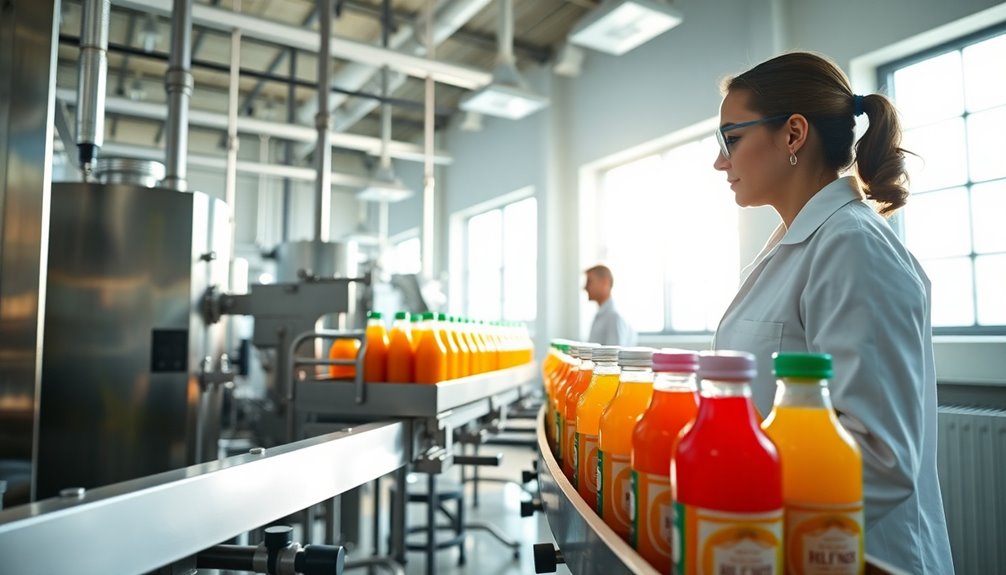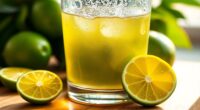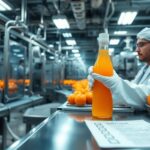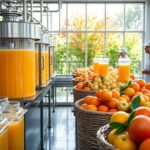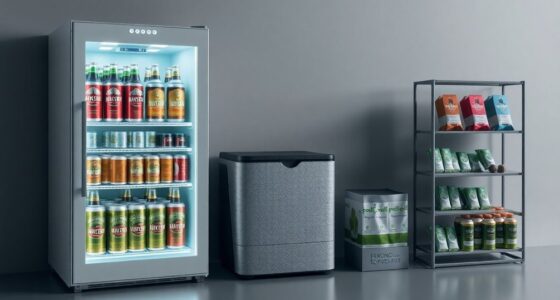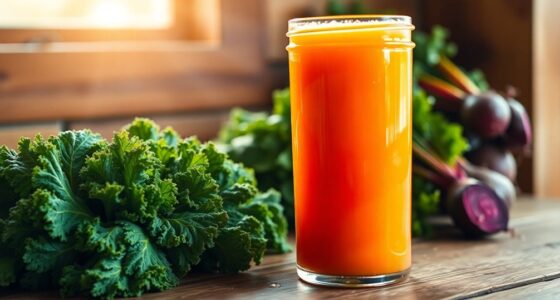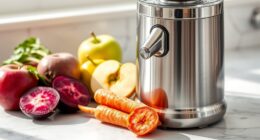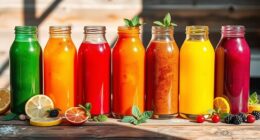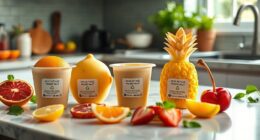Juice manufacturing processes are strictly health regulated to safeguard you from potential contaminants. Regulations like HACCP help guarantee producers achieve a safe 5-log reduction in harmful pathogens. Licensing and routine inspections further assure quality and safety. You're also protected from hazards like microbial contamination and pesticide residues. These measures not only enhance your health but also boost consumer trust. Discover more about how these regulations maintain juice quality and safety for everyone.
Key Takeaways
- Juice manufacturing processes are strictly regulated to prevent microbial contamination, ensuring consumer safety from pathogens like E. coli and Salmonella.
- Compliance with HACCP standards mandates routine monitoring to achieve a 5-log reduction in harmful microorganisms in juice products.
- Licensing requirements, such as annual food permits, promote adherence to safety protocols and maintain product quality in juice manufacturing.
- Raw juice regulations, including proper refrigeration and shelf life limits, protect consumers from health risks associated with non-pasteurized products.
- Best practices in juice production, including thorough washing and pasteurization, are essential to minimize hazards and ensure safe, high-quality juice.
The Role of HACCP in Ensuring Juice Safety
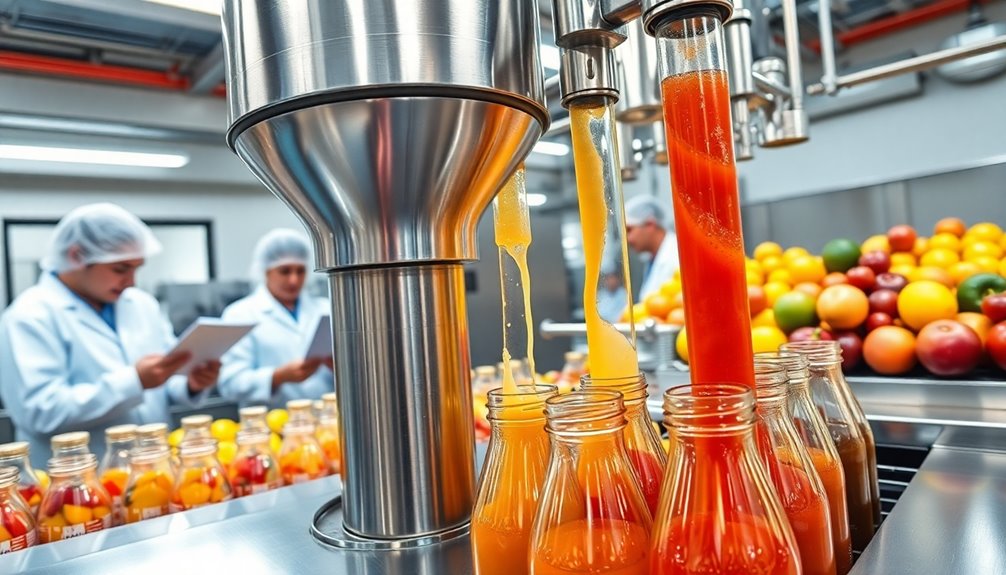
When it comes to juice safety, the Hazard Analysis and Critical Control Points (HACCP) system plays an essential role in managing food safety risks. By focusing on critical control points (CCPs), you can effectively prevent contamination throughout the juice production process.
Juice processors must achieve a 5-log reduction in pathogens like E. coli and Salmonella, which greatly lowers the risk of foodborne illnesses. Thanks to HACCP compliance, juice-related outbreaks have markedly decreased, with only 21 reported outbreaks from 1995 to 2005.
To maintain safety and quality, routine monitoring and documentation are required at every stage, including raw material reception and storage. The FDA mandates these regulations for all juice processors, ensuring rigorous safety standards across the industry. These procedures not only help in identifying any potential hazards but also serve to uphold transparency throughout the production process. By adhering to established best practices for juice manufacturing, companies can effectively minimize risks and enhance the overall quality of their products. Additionally, regular audits and staff training play crucial roles in reinforcing these protocols and ensuring compliance with FDA regulations.
Understanding Raw Juice Regulations
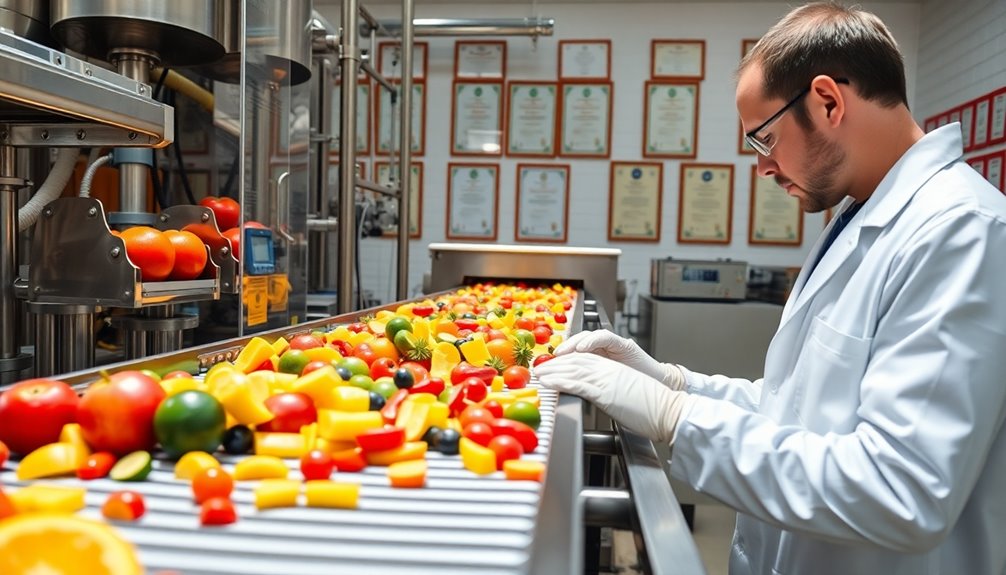
Understanding the regulations surrounding raw juices is vital for anyone involved in their production or sale.
In South Carolina, the Department of Health and Environmental Control (SC DHEC) regulates these beverages, classifying them as liquids derived from fruits or vegetables. If you're preparing raw juices on-site, you'll need to apply for a variance and may have to develop a HACCP plan to guarantee compliance.
It's essential to keep your juices refrigerated below 41°F and to adhere to the maximum shelf life of 7 days to prevent foodborne illnesses. Your HACCP plan must guarantee a 5-log reduction of harmful microorganisms, and remember, all products must carry a warning label indicating they haven't been pasteurized.
The Importance of Licensing for Juice Manufacturers
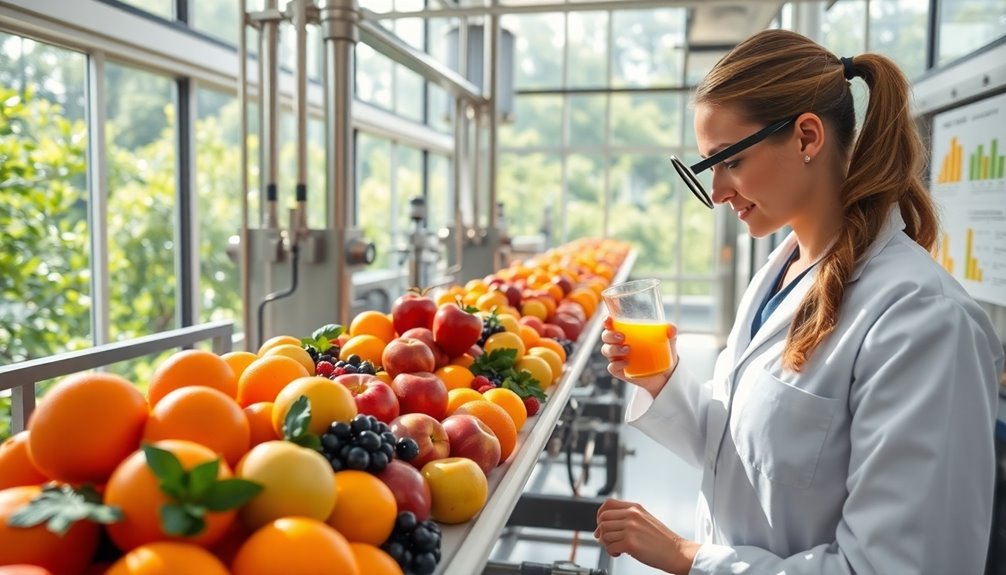
To guarantee the safety and quality of juice products, obtaining the proper licenses is essential for juice manufacturers. You must register with local health departments and secure food permits, much like restaurants do, to confirm compliance with health and safety standards.
For instance, in Florida, you're required to acquire an Annual Food Permit and undergo inspections. In Texas, registration with the State Department of Health Services is mandatory, where your facility must meet zoning rules and pass inspections.
Remember, licenses typically need annual renewal, and failing to follow licensing regulations can result in fines or even business closure.
Partnering with experts like CT Corporation can simplify steering through these complex regulations, helping you maintain compliance and prioritize food safety.
Common Hazards in Juice Production
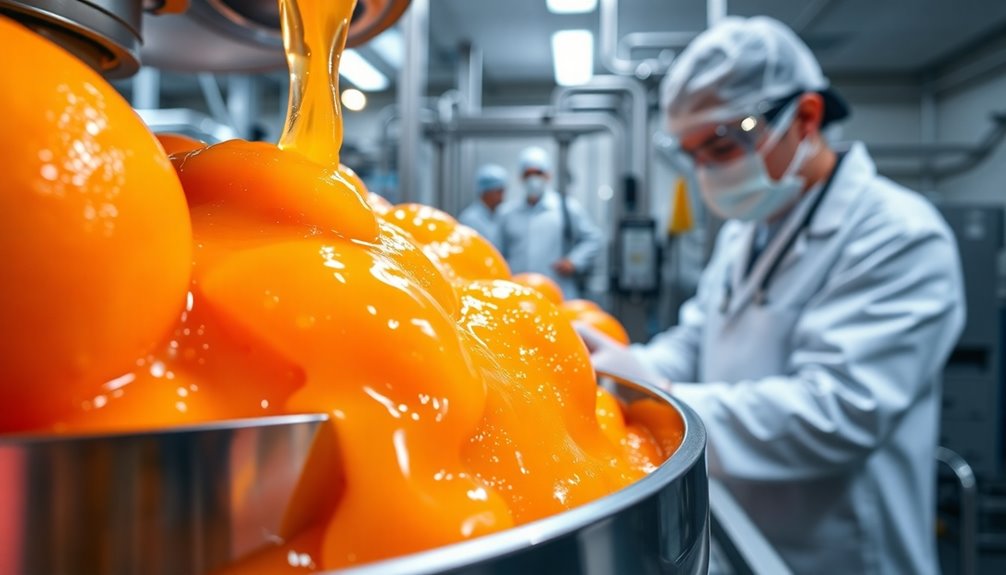
Ensuring juice safety requires awareness of common hazards that can occur during production. You need to be vigilant about microbial contaminants like E. coli and Salmonella, which can survive in juice and pose serious health risks. Mycotoxins from fungi can also be present, often exceeding safety limits. Additionally, physical contaminants such as glass or metal fragments may accidentally enter the juice. Chemical contaminants like pesticide residues highlight the importance of monitoring critical control points (CCPs) throughout the process.
| Hazard Type | Example | Health Risks |
|---|---|---|
| Microbial Contaminants | E. coli, Salmonella | Foodborne illness |
| Mycotoxins | Patulin | Long-term toxicity |
| Physical Contaminants | Glass, metal fragments | Injury or choking risk |
Best Practices for Maintaining Juice Quality and Safety
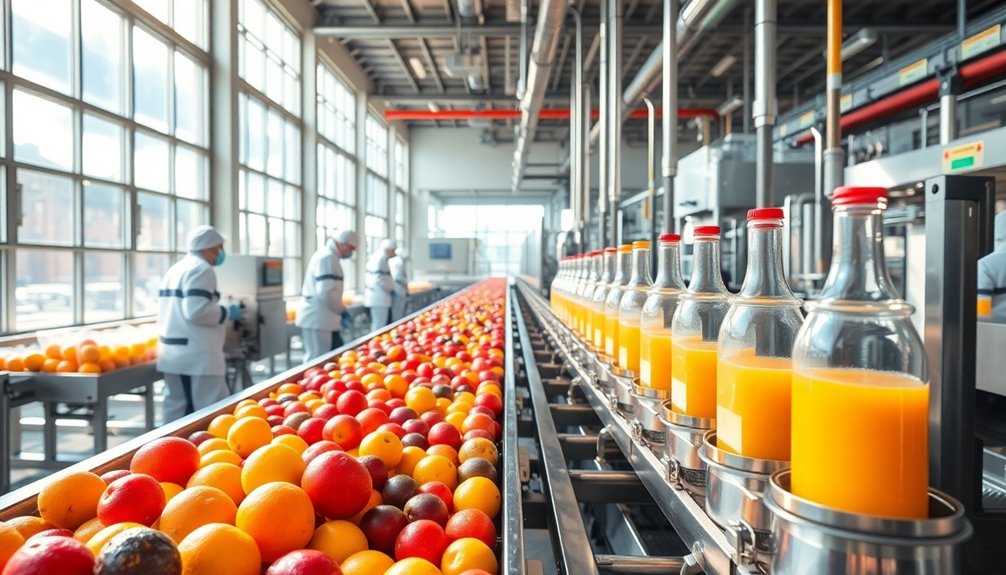
Maintaining juice quality and safety demands a proactive approach, especially after identifying common hazards in production.
As a juice producer, you must adhere to Hazard Analysis and Critical Control Points (HACCP) regulations to mitigate risks effectively. Implementing robust quality control measures guarantees that every step of your process is safe and compliant.
- Wash fruits and vegetables thoroughly to remove contaminants.
- Use heat-pasteurization or high pressure processing (HPP) to guarantee safety.
- Regularly train employees on hygiene practices and pathogen reduction. Additionally, incorporating nutritional advantages of green juice into your product line can enhance health benefits for consumers.
Frequently Asked Questions
Is Juice Regulated by the FDA?
Yes, juice is regulated by the FDA.
You'll find that the FDA enforces strict guidelines under the Juice Hazard Analysis and Critical Control Points (HACCP) system. This means juice processors must achieve a 5-log reduction in harmful pathogens.
They require pasteurization or treatment to eliminate bacteria, ensuring your juice is safe to consume.
These regulations have greatly decreased juice-related outbreaks, protecting your health and well-being when enjoying your favorite beverages.
What License Do You Need to Sell Juice Online?
Think of selling juice online like opening a restaurant; you can't just start without the right licenses.
You'll need to register with your local health department and obtain food permits specific to your state, like Florida's Annual Food Permit or Texas's registration with the Department of Health Services.
It's crucial to guarantee compliance with the FDA's HACCP guidelines too.
Seeking help from services like CT Corporation can simplify this process for you.
What Is the Best Way for an Approved Source to Reduce the Number of Harmful Microorganisms in Pre-Packaged Juice?
To reduce harmful microorganisms in pre-packaged juice, you should implement effective methods like heat-pasteurization to eliminate bacteria or consider high pressure processing (HPP) for a non-thermal option.
Regularly inspect your facilities and maintain strict hygiene protocols.
It's essential to continuously monitor both raw materials and finished products to catch any contamination early.
Following established food safety plans and ensuring proper cleaning of transport tankers will also help keep your juice safe for consumers.
What Are the Hazards of Juices?
When you sip juice, you might imagine a revitalizing waterfall, but lurking beneath that surface are potential hazards.
Contaminated produce can introduce harmful pathogens like E. coli and Salmonella into your drink. Mycotoxins and pesticide residues may also sneak in, putting your health at risk.
Even physical contaminants like glass can find their way into the mix. So, it's essential to guarantee your juice is produced with strict safety measures to keep your glass clean and safe.
Conclusion
In the vibrant world of juice manufacturing, safety isn't just a guideline—it's a lifeline. By embracing HACCP principles, adhering to strict raw juice regulations, and maintaining robust licensing, you're not only safeguarding your product but also nourishing your customers' health. Picture a sunlit orchard, where every drop of juice reflects the dedication to quality and safety. As you navigate the complexities of juice production, remember: your commitment to health is the essence that transforms fresh fruit into pure energy.
Cindy thoroughly researches juicing trends, techniques, and recipes to provide readers with practical advice and inspiration. Her writing style is accessible, engaging, and designed to make complex concepts easy to understand. Cindy’s dedication to promoting the advantages of juicing shines through her work, empowering readers to make positive changes in their lives through the simple act of juicing.

